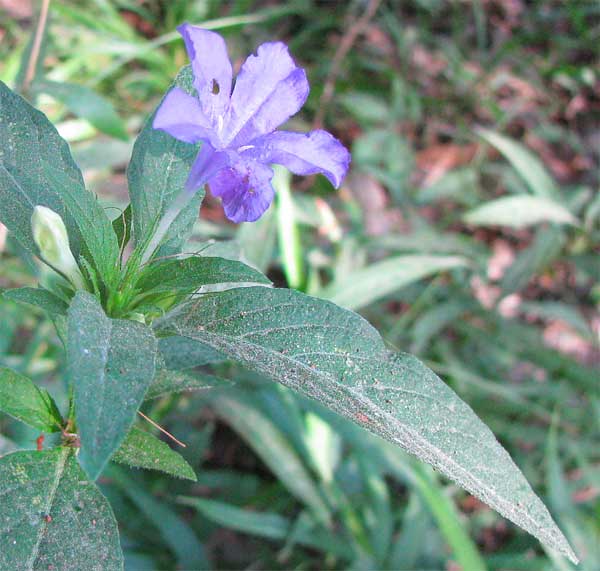Excerpts from Jim Conrad's
Naturalist Newsletter

from the the June 23, 2008 Newsletter, issued from the forest near Natchez, Mississippi; elevation ~400ft (120m), ~N31.47°, ~W91.29°:
WILD PETUNIAS
Compared to spring and fall, right now native wildflowers are keeping a low profile. However, there are a few. Since by now it's too hot and buggy for most hikers to wander in the woods, names of these early-summer wildflowers are not well known, and the wildflowers themselves go underappreciated.
One of the most conspicuously flowering wildflowers of upland woods around here right now is the one shown above. That's the Wild Petunia, genus RUELLIA, Ruellia caroliniensis. Weakley's Flora of the Carolinas lists eight Ruellia species for the US Southeast. Up in Kentucky we had three species. All Ruellias produce 1.5-inch-long, purplish flowers from leaf axils, the blossoms consisting of slender corolla tubes that flair into five spreading lobes. At the flower's throat you find four stamens. All Ruellias have opposite leaves with toothless margins.
Ruellia species are found in a number of distinct habitats. For instance Ruellia humilis pefers dry, calcareous, rocky ground while Ruellia ciliosa likes sand hills, and Ruellia noctiflora goes for wet pinelands and savannas. Therefore, if you hike much at this time of year, there's a good chance you'll see Ruellias, no matter where you are in the Eastern Forest Biome.
Ruellias are members of the Acanthus Family, in which we also find the Water-willow and some other not-very- famous plants. They really have nothing to do with petunias other than their flowers being vaguely shaped like petunias, which are in the Nightshade or Tobacco Family.